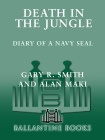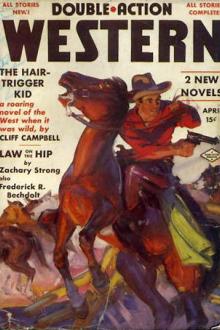Death in the Jungle by Gary Smith (most inspirational books .txt) 📕

Read free book «Death in the Jungle by Gary Smith (most inspirational books .txt) 📕» - read online or download for free at americanlibrarybooks.com
- Author: Gary Smith
Read book online «Death in the Jungle by Gary Smith (most inspirational books .txt) 📕». Author - Gary Smith
Relieving (the watch, the duty, et cetera): To take over the duty and responsibilities, as when one sentry relieves another. Those who relieve are “reliefs.”
Request mast: Mast held by captain or executive officer to hear special requests for leave, liberty, et cetera
R&R (Rest and Relaxation): A welcome policy established and used by U.S. Armed Forces in Vietnam. Individuals generally became eligible for a five-day R & R after six months in country. They could choose such places as Bangkok, Thailand; Manila, Philippines; Sydney, Australia; Taipei, Taiwan; and Vung Tau or Nha Trang, Vietnam. Honolulu, Hawaii was especially popular with the married men, who would arrange to meet their spouses there.
Rig: General description of a ship’s upper works; to set up, fit out, or put together.
Rigging: General term for all ropes, chains, and gear used for supporting and operating masts, yards, booms, gaffs, and sails. Rigging is of two kinds: standing rigging, or lines that support but ordinarily do not move; and running rigging, or lines that move to operate equipment.
Ropeyarn Sunday: A time for repairing clothing and other personal gear. (Usually Wednesday afternoon at sea.)
Sampan: A small Vietnamese boat propelled by paddle or motor.
Scow: Large, open, flat-bottomed boat for transporting sand, gravel, mud, et cetera.
Scullery: Compartment for washing and sterilizing eating utensils.
Scuttlebutt: Container of drinking water, or a drinking fountain. Also, a rumor, usually of local importance.
Sea lawyer: Enlisted man who likes to argue, usually one who thinks he can twist the regulations and standing orders around to favor his personal inclinations.
SEAL Teams: SEAL Teams 1 and 2 were commissioned on 1 January 1962, and were located at Coronado, California, and Little Creek, Virginia, respectively. All of the original SEALs were formerly UDTs. However, as the Vietnam War escalated, some individuals were assigned directly to a SEAL Team from the training unit. Shortly thereafter, UDT training was renamed BUDS (Basic Underwater Demolition SEAL). SEAL is an acronym formed from sea, air, and land. SEALs can attack from the sea, the air, and the land. SEAL Teams are organized, trained, and equipped to conduct unconventional warfare, counter-guerrilla, and clandestine operations in maritime areas and riverine environments. This includes, but is not limited to, the following: demolitions, intelligence collection, and training and advising friendly military and paramilitary forces in the conduct of Naval Special Warfare.
Seaworthy: Capable of putting to sea and meeting usual sea conditions.
Secure: To make fast; to tie; an order given on completion of a drill or exercise, meaning to withdraw from drill stations and duties.
Semaphore: Code indicated by the position of the arms; hand flags are used to increase readability.
Service stripes: Diagonal stripes on the lower left sleeve of an enlisted man’s uniform denoting periods of enlistments. Usually referred to as “hash-marks.”
Set: Direction of the leeway of a ship or of a tide or current.
Shellback: Man who has crossed the equator and been initiated.
Shipshape: Neat, orderly.
Shore patrol: Naval personnel detailed to maintain discipline, to aid local police in handling naval personnel on liberty or leave, and to assist naval personnel in difficulties ashore.
Sick bay: Ship’s or command’s hospital or dispensary. On Monday the dispensary is filled; on Friday the dispensary is empty.
Skivvy: Slang for underwear.
Slick: Common, cross-service slang for a UH-1 “Huey” helicopter armed only with two M-60 machine guns, located on each side and aft of the passenger/cargo area. Each slick can carry one squad, or seven men, with full combat gear.
Smoking lamp: A lamp aboard old-time ships used by men to light their pipes; now used in the phrase, “The smoking lamp is lit (or out),” to indicate when men are allowed (or forbidden) to smoke.
Snipes: Slang for members of the engineering department.
Sonar (sound navigation and ranging): Device for locating objects under water by emitting vibrations similar to sound, and measuring the time taken for these vibrations to bounce back from anything in their path.
SOP: Standing operating procedure based upon lessons learned and military wisdom.
Sound: To measure depth of water by means of a lead line. Also, to measure the depth of liquids in oil tanks, voids, blisters, and other compartments or tanks.
Squad: A subdivision of a platoon. The squad was made up of seven men. There were two squads in each SEAL platoon.
Squall: Sudden gust of wind.
Square away: To get things settled down or in order.
STAB (SEAL Team Assault Boat): Twenty-six feet in length, powered by two 325-horsepower motors, and drew four feet of water. Its maximum range was 450 nautical miles. It was manned by Boat Support Unit personnel and used to insert and extract one squad of SEAL personnel. It was also used for fire support.
Staff officer: Officer of staff corps, (medical, dental, supply, et cetera), whose duty was primarily within his specialty, and not of a military character. Also, a line officer when assigned to the staff, or group of assistants, of a high-ranking officer.
Stage: Platform rigged over ship’s side for painting or repair work.
Stand by: Preparatory order meaning “Get ready,” or “Prepare to.”
Starboard: Right side of a ship looking forward.
Stateroom: Officer’s shipboard bedroom.
Stern: After part of a ship.
Stow: To put gear in its proper place.
Striker: Enlisted man in training for a particular rating.
Swab: A rope or yarn mop.
Sweepers: Men who use brooms in cleaning ship when “clean sweep down” is ordered.
T-10: An operational area within the northeastern portion of the RSSZ (Rung Sat Special Zone). It was composed of very dense vegetation and double-canopy forest. It was generally surrounded by swampy terrain and numerous streams that were very difficult for any foot soldier to penetrate. For these reasons, the United States and its allies rarely penetrated its interior. Even then, it was done carefully and by warriors who were specially trained to deal with the riverine environment. The NVA/VC used the T-10 extensively for an R & R and troop-staging area





Comments (0)